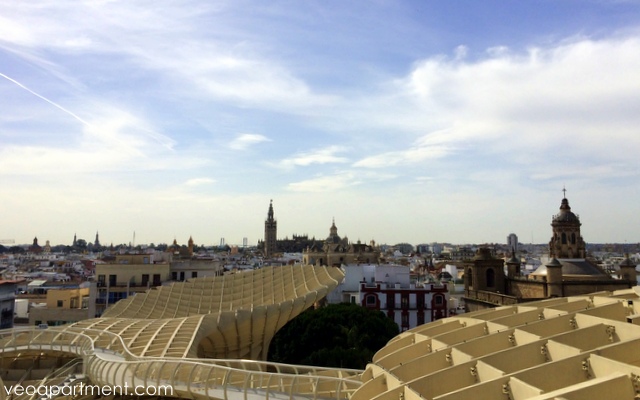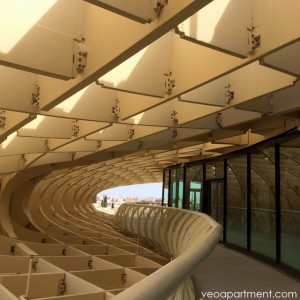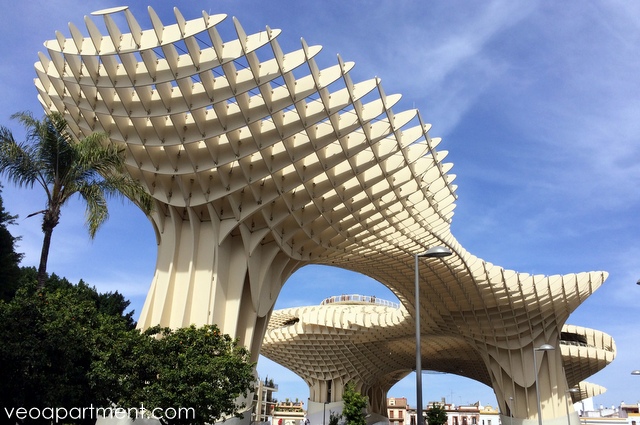Overpriced, overdue and out of place – Seville’s Metropol Parasol (popularly known as “las Setas”, or the mushrooms) has been no stranger to controversy, but since it’s completion in early 2011, it’s curving, swooping ultra-modern shape has become an important tourist attraction in the heart of the old city, and helped to revitalise an area that had become rather run down.

The Parasols can be found in the Plaza de la Encarnación, straddling the main east-west streets Calle Laraña and Calle Imagen. The square is named for the late mediaeval monastery that stood here until the early 19th century, when it was demolished to make way for a new central provisions market (whose successor is on the ground floor). In the 1970s the area was the target of “urban renewal” and the market building (by then in a poor state of repair) was pulled down, and the stall holders moved to “temporary” accommodation on a vacant lot beside the square. Although it had always been the intention to restore the market to its original location, the site was effectively abandoned until 1990, when work began on a proposed underground car park. But after substantial Roman ruins were discovered on the site, work stopped, plans were shelved, and the archaeologists moved in. Finally, in 2004 the local council held a competition for a design for a new market building in the square, which was won by the German architect Jürgen Mayer-Hermann‘s futuristic parasols. Despite technical and financial problems the project was finally completed in April 2011.
 But it was all worth it in the end. The first time you see them is definitely one of those “Wow!” moments. Said to be the largest wooden structure in the world, it swoops and arches above you like, well, a giant mushroom. But it’s functional, too. At ground level, as promised, is the Encarnación market, back in its rightful home after a break of 37 years, with shops and bars alongside. The roof of the market provides an open space for public events, especially the Christmas fair, world cup finals on the big screen, and occasional concerts. Below ground-level is the Antiquarium, the museum that houses the Roman ruins, which have been carefully restored and are a must-see for anyone with an interest in history. From there you can also take the lift up to the top. The walkways give you a great view of the surroundings, and you can enjoy a drink and a tapa at the Gastrosol bar complex.
But it was all worth it in the end. The first time you see them is definitely one of those “Wow!” moments. Said to be the largest wooden structure in the world, it swoops and arches above you like, well, a giant mushroom. But it’s functional, too. At ground level, as promised, is the Encarnación market, back in its rightful home after a break of 37 years, with shops and bars alongside. The roof of the market provides an open space for public events, especially the Christmas fair, world cup finals on the big screen, and occasional concerts. Below ground-level is the Antiquarium, the museum that houses the Roman ruins, which have been carefully restored and are a must-see for anyone with an interest in history. From there you can also take the lift up to the top. The walkways give you a great view of the surroundings, and you can enjoy a drink and a tapa at the Gastrosol bar complex.
The neighbouring streets have been rejunevated too, especially the two areas of small boutiques, Soho Benita and Regina, with their emphasis on local designers and artworks, and the open part of the square with trees and benches is a pleasnt place to sit in the shade of a summers day. This is a part of Seville that’s fairly new to tourism, but as the mushrooms have drawn people here, it has become a busy vibrant space, and one of the city’s treasures.

The walkways and bar are open from 10:30am to midnight, entrance €3.00 (though you get a discount on your first drink), and the Antiquarium from 10.00am to 8.00pm Tuesday to Saturday and 10.00am to 2.00pm Sundays, entrance €2.
Veoapartment has five holiday apartments in Laraña with views of the Parasols.
Pingback: Seville | Alameda de Hercules | veoapartment
Pingback: Seville | holiday tips | veoapartment
Pingback: Seville | El Centro | veoapartment
kaffeto Gourmet products are without a doubt some of the most beneficial drinks that you can consume on daily basis and feel good about the products you are putting into your body. Kaffeto Gourmet’s coffee is not only delicious and high quality but also has multiple health benefits.